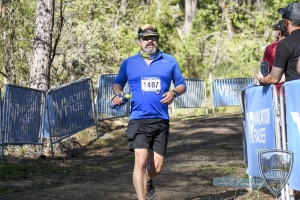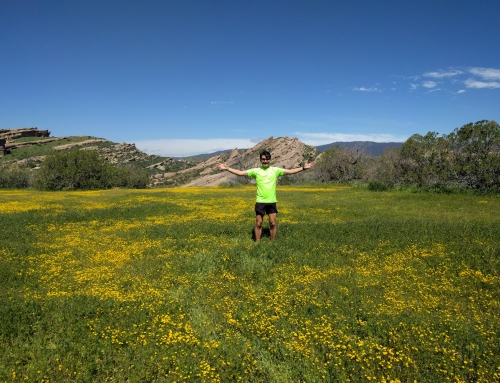Older runners should listen to their bodies. Do you? Over the years I’ve seen many runners, novices and experienced alike, consciously ignore how they feel before, during and after their runs. These runners are usually working through a training plan towards a goal race. Runners often have a hell or high-water stubbornness to stick to the plan regardless, because they’d been told that’s how you improve. Runners in general seem to have it in their DNA, seemingly pre-disposed to toughing it out, ignoring pain and discomfort as if it were a badge of courage. They may chalk up the lingering fatigue and discomfort days after a session to a “tough workout” thinking if there’s no prolonged pain, there will be no gain. Sound familiar?
There are times when this approach may be appropriate, such as for certain key workouts with a specific objective in mind or when pushing through an important goal race. Younger runners can get away with it. For many of us aging runners, a more cautious and conservative approach is more appropriate. One that hinges upon “acting” on the feedback that our body provides. It’s the best approach to improving and maintaining fitness while remaining healthy and injury free. Remember, if you are injured or sick, you aren’t running, and if you aren’t running, your body is in the process of de-training. 
What Listening To Your Body Means
First, let’s start with what “listening” to your Body means. Listening is not complicated. It’s really just about having an awareness of whatever feedback your body is providing you. You want to be cognizant of what you are feeling in the moment. We call this “mindfulness“. Second, It’s about using this information to assess your current physical status relative to what you consider to be “your” norm or your baseline “feeling good” condition. It’s another way of saying that you are in “tune” with your current physical status and well being. You are aware of and understand what or how you are feeling.
Finally, you want to take the process a step further by honing your ability to feel or sense your status and condition beyond just while you are running or exercising. You start by categorizing your run in general terms, are you feeling good or really crappy today? After you are adequately warmed up, has anything changed? (i.e. still feeling good, improved, or still bad). Then you start extending this awareness throughout your day and during other activities.
Here are some training tips from my blog to get you started (link): 3-Essential Training Tips For Older Runners
Some Examples
Examples of this would be when you first wake up in the morning after you’ve take your first few steps. You notice you have a little hitch in your step. Will it work itself out after you move around a bit or will it linger throughout the day? Or, maybe you are working in the yard and you feel a progressing tightness in your lower back. Do you continue or take a little break from the task to loosen up and give those muscles a break? How about this one. You’ve been working at your desk all morning and start to feel your hamstrings/glutes getting tighter. Is it time to get up and move around or stretch a bit? These are just a few examples that may have the potential to impact your running later in the day if you simply dismiss them.
Don’t Ignore The Little Things
You don’t want to ignore the little things. The older runners should listen to their bodies. The take away here is to not instinctively dismiss what may seem at the time to be minor anomalies. Rather, think of them as little cues as to what may be going on with your body. Too many runners are blindly driven by the axiom of “no pain, no gain” as the only road to success. By just taking a moment to consciously assess or analyze what feels amiss, you may save yourself a lot of anguish down the line.
Things like: that sharp or intermittent pain in a muscle or joint. The unusual tightness in the calf or deep achiness in the upper hamstring/glute. A hot spot on the ball of your foot or toe. Noticing your pace today is off relative to your perceived exertion level. Maybe you just can’t finish those last couple of intervals like you usually do. These are potential red flags for the older runner. For the younger runners, they can generally get away with it unscathed and can just chalk it up to an off-day. However, older runners should listen to their bodies to reduce the risk of incurring training related injuries.
However, for an aging runner, left ignored, these cues may be a signal that trouble may be brewing. By the same token, we don’t want to become walking hypochondriacs. Not every little discomfort portends a potential injury. By just taking a moment to assess the ache or pain, you create an opportunity to stave off a potential training injury. And should you become injured, the worst thing you can do is try to train or run through it, which presents an environment ripe for creating a chronic recurring injury down the line.
Develop Your Awareness Skills
Having the skill to listen to your body connotes an uncanny understanding and appreciation of your body and what it can or can’t do. It’s a skill that needs to be developed through experience and application. Practice makes perfect. It means learning to pay attention to the little things your body might be signaling to you. It’s learning and knowing what’s normal for you and what’s not. It means not ignoring pain and discomfort or trying to tough it out if you are genuinely hurt. It’s also about learning to tell the difference between acute pain (which may signal a possible injury) and the “normal” post-workout achiness and discomfort (DOMS) associated with a long or tough workout. “DOMS” is an acronym for delayed onset muscle soreness, which is the discomfort/pain felt most strongly approximately 24-72 hours after vigorous exercise.
Athlete’s have a Developed Sense of Awareness
Athletes have a developed sense of awareness for what’s going on with their bodies through years of experience and training. And, its not just limited to when they are working out. They are “listening” all the time…. before workouts, after workouts, when they get up in the morning and throughout the day even as they engage in other activities. You should too! Older runners should listen to their bodies.
Why do we want to be so aware of our bodies and current condition? The little anomalies we sense are like red flag warnings. These red flags tell us to be on alert, and that maybe something might not be right. Remember, running is a highly repetitive activity that’s coupled with the stress of impact and gravity. Let’s put this in perspective. Consider this: running 3-miles at a 10 minute/per mile pace with an average cadence of 170 strides per minute equates to approximately 5,100 footstrikes. As if that isn’t enough, consider that each footstrike can exert the force of up to three times your body weight on the foot. That’s a lot of stress.
One of the things ultrarunners quickly learn is that “little” things do matter. If measures are not immediately taken to mitigate the problem, it can mean the difference between finishing the race or having to DNF (Did Not Finish). This applies to older runners as well, even if you aren’t doing consistently high volumes.
Little Things Can Become Big Problems
As runners, most of us have learned the hard way that seemingly little things can quickly turn into bigger problems that can jeopardize our training. The old adage, “No pain, No gain” doesn’t work very well for aging runners, especially as we get into our upper 50’s and 60’s. For us older runners, avoiding injuries is of paramount importance. That’s because it takes us a lot longer to heal and recover. Obviously, you want to keep injuries from recurring or becoming chronic.
You might recall Franklin’s saying that “an ounce of prevention is worth a pound of cure”. Well, it’s no truer than when it’s applied to an older runner. An extra day of rest or even two could save you from incurring an injury. An Injury has the potential to devastate your training for weeks or months. Keep in mind that continued running on an injury; even a very minor one can alter your mechanics and gait. This imbalance can serve as a catalyst for other injuries along your kinetic chain or even on your good side. Older runners should listen to their bodies.
Have Patience, But Be Diligent
Like any new skill, it takes practice, and then even more practice with a lot of patience along the way. Good skills don’t materialize overnight. Learning to listen to your body is no different. Be patient, but diligent and honest about what you feel. I’ve found it best to start with your short easy runs. This is essentially your baseline for comparisons. It’s easier to focus your attention on how things are feeling during a “normal” low-intensity run. These runs normally feel “good”.
You will want to periodically go through a mental checklist. Start from your head and work your way down to your toes. It’s like performing a quick diagnostics on your body. Does anything feel different or out of the ordinary? You are probably already doing this when doing drills or when working on your running “form”. The skill set is the same. Its being mindful, but we’re now taking it beyond just the form elements. Then you can progress to applying your skills to other types of workouts and activities. Remember, how you feel doing repeats, intervals or hill work is going to be very different from how you feel on a regular run, but now you have a frame of reference with which to compare. Make it a “habit” to run through your mental checklist routinely during the course of your run(s) or other activity. Before you know it, listening to your body will become second nature.





